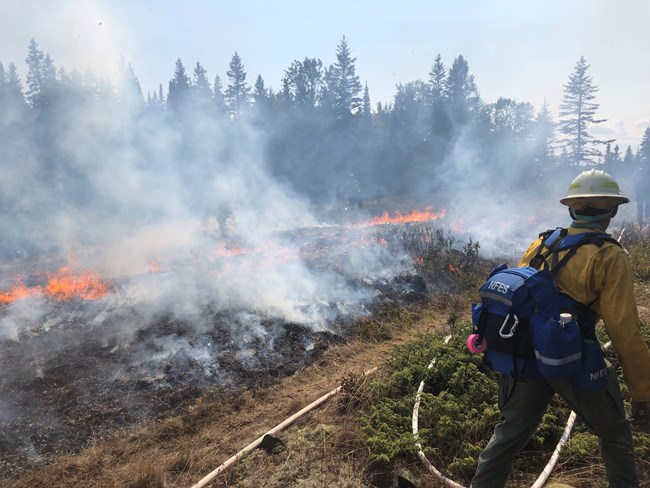
NPS This is a list of wildland fire terminology used throughout Isle Royale National Park's webpage. For more information, see the complete Glossary of Wildland Fire Terminology, published by the National Wildfire Coordinating Group. BackfireA fire set along the inner edge of a fireline to consume the fuel in the path of a wildfire or change the direction of force of the fire's convection column. BlowupSudden increase in fireline intensity or rate of spread of a fire sufficient to preclude direct control or to upset existing suppression plans. Burning ConditionsThe state of the combined factors of the environment that affect fire behavior in a specified fuel type. ContainmentThe status of a wildfire suppression action signifying that a control line has been completed around the fire, and any associated spot fires, which can reasonably be expected to stop the fire’s spread. Creeping FireFire burning with a low flame and spreading slowly. Also known as smoldering.Crown FireA fire that advances from top to top of trees or shrubs more or less independent of a surface fire.Defensible SpaceThe buffer between a building and the grass, trees, shrubs, or any wildland area that surround it. This space is needed to slow or stop the spread of wildfire and it helps protect structures from catching fire—either from embers, direct flame contact or radiant heat. Fire BehaviorThe manner in which a fire reacts to the influences of fuel, weather, and topography.Fire CampA geographical site(s), within the general incident area, separate from the incident base, equipped and staffed to provide sleeping, food, water, and sanitary services to incident personnel. Fire DependentPlants and vegetation communities which have evolved adaptations such as a reliance on fire as a disturbance agent, protection as a species against the effects of wildland fire, or even a strengthening or enhancement by it. Fire EcologyThe study of the effects of fire on living organisms and their environment.Fire EffectsThe physical, biological, and ecological impacts of fire on the environment. Fire ManagementActivities required for the protection of burnable wildland values from fire and the use of prescribed fire to meet land management objectives. Fire Management UnitA land management area definable by objectives, management constraints, topographic features, access, values to be protected, political boundaries, fuel types, major fire regime groups, etc. that set it apart from the characteristics of an adjacent FMU. The FMU may have dominant management objectives and pre-selected strategies assigned to accomplish these objectives. FirelineThe part of a containment or control line that is scraped or dug to mineral soil. FlammabilityThe relative ease with which fuels ignite and burn regardless of the quantity of the fuels. FlammableEasily ignitable and capable of burning and producing flames. Fuel ManagementAct or practice of controlling flammability and reducing resistance to control of wildland fuels through mechanical, chemical, biological, or manual means, or by fire, in support of land management objectives. FuelAny combustible material, especially petroleum-based products and wildland fuels. Hot SpotA particularly active part of a fire. Humidity RecoveryThe change in relative humidity over a given period of time; generally between late evening and sunrise. The fuel moisture change during this period is directly related to the amount of humidity recovery. Incident CommanderThis position is responsible for overall management of the incident and reports to the Agency Administrator for the agency having incident jurisdiction. This position may have one or more deputies assigned from the same agency or from an assisting agency(s). LookoutA person designated to detect and report fires from a vantage point. Lookout TowerAlso known as fire tower. Structure that elevates a person above nearby obstructions to sight for fires; generally capped by some sort of house or cupola. Maintenance BurnIn prescribed fire terminology, a fire used to dispose of scattered, piled, or windrowed dead woody fuel, generally in the absence of a merchantable overstory. Its purpose is to reduce unsightly fuel concentrations, or consume unwanted natural fuels to facilitate subsequent resource management or land use actions on the area. Marine InversionTemperature inversion produced when cold marine air underlies warmer air. Mop UpExtinguishing or removing burning material near control lines, felling snags, and trenching logs to prevent rolling after an area has burned, to make a fire safe, or to reduce residual smoke. Natural Disturbance AgentAgents of regeneration and restoration in an ecosystem, such as wildfire, wind, insect epidemics, etc. Prescribed FireAny fire ignited by management actions to meet specific objectives. A written, approved prescribed fire plan must exist, and NEPA requirements (where applicable) must be met, prior to ignition. Relative HumidityThe ratio of the amount of moisture in the air, to the maximum amount of moisture that air would contain if it were saturated. The ratio of the actual vapor pressure to the saturated vapor pressure. Single Engine Airtanker (SEAT)The smallest airtanker. These aircraft can deliver up to 800 gallons fire retardant or water to wildland firefighters on the ground. They are ideal for wildfires in lighter fuels like grasses and sagebrush. Spot FireFire ignited outside the perimeter of the main fire by a firebrand, or ember. SuppressionAll the work of extinguishing or confining a fire beginning with its discovery. TorchingThe burning of the foliage of a single tree or a small group of trees, from the bottom up. Wildland Urban Interface (WUI)The line, area, or zone where structures and other human development meet or intermingle with undeveloped wildland or vegetative fuels. HomeFire on Isle Royale |
Last updated: September 13, 2023
